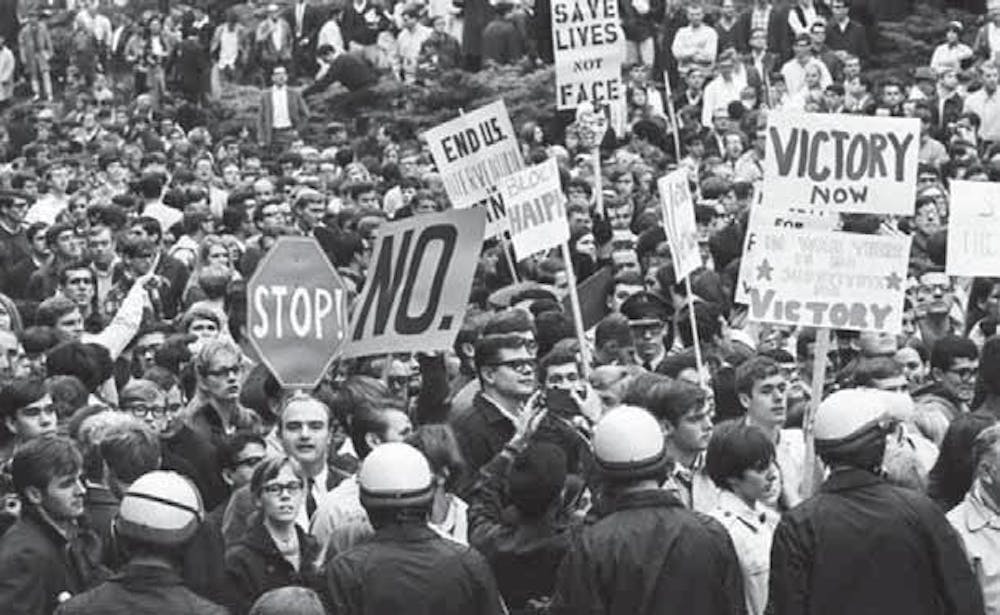I’m hunched over a phone in the Monroe County Public Library, surrounded by a handful of other IDS staffers. We’re watching a live stream of Dunn Meadow. It’s April 25.
On the screen, students are being violently ripped away from the crowd and restrained by police. We see one student have their arms and legs ziptied and then hauled away by armored officers. “Take a screenshot,” someone in the newsroom insists. The person holding the phone obliges.
I’m pacing the room, full of nervous energy. I frantically text a friend who is attending the protest. She tells me state troopers are surrounding the protestors. “I won’t lie when I say I’m scared,” she says.
I can’t rip my eyes from the screen. The biggest thought running through my mind, in a maelstrom with others: this can’t be happening right now. This is something I read about in history textbooks, not something that happens two blocks away on a previously peaceful, grassy field.
How can this be happening?
For years, Dunn Meadow has been a bastion of free expression on IU’s campus. Take 1991’s protest against the Gulf War, which saw students camping overnight for 45 days — not unlike the current encampment installed in the meadow.
Similarly, Dunn Meadow saw thousands of students come together in 1969 to protest sharp tuition increases while the Vietnam War raged. Antiwar activism was widespread across campus and rose to a head in 1970 when President Nixon announced the expansion of the war into Cambodia.
Despite overwhelming unrest during the 1970 protests, police and the National Guard never clashed with protestors. Though the administration called them to the edge of town, they were never utilized.
In 1968, as well, civil rights demonstrators occupied the (now demolished) Tenth Street Stadium for three days. Armed only with shields and sticks, the protestors demanded fraternities rescind anti-Black discriminatory clauses to race in the upcoming Little 500.
And it worked. IU President Elvis Jacob Stahr Jr. encouraged the Greek houses to comply. Only one day delayed from the original date of the race, all but one fraternity took part in the Little 500.
The extended protests and encampments against apartheid in South Africa throughout the 1970s, ‘80s and ‘90s were most similar to this week’s demonstrations. Students demanded divestment from companies that operated in South Africa at the time.
Students took many protest tactics during these decades, including a “shantytown” encampment in Dunn Meadow. First built in April 1986, the shantytown lasted through the summer and into the fall semester — proving just how long these energies can truly last. Ultimately, the Board of Trustees passed new policies regarding South African companies and investments were reduced heavily.
These various examples show that student demonstrations can and will work. It takes time and an administration that is willing to hear them out rather than silence them.
On Thursday evening, I make it to Dunn Meadow. The sun is warm, sinking behind Franklin Hall. A circle of protestors chants and cheers. The police are nowhere to be seen.
I see friends. We hug. We chant together, following the lead of a drummer and an ever-changing student with a megaphone in the center.
What I saw most there was resilience. These were people who saw one of the most violent expressions of power directly in their faces, stood up to it and said “no.” They still stood in that field, even if their tents were ripped down, even if they were beaten and bruised from batons and being shoved to the ground, and chanted for freedom.
What we see now is an unprecedented violent response to student activism at IU. Though student protests will always face backlash from those in power, almost no administrative response in IU’s history has been this overwhelming.
But what is unique about student protests is the ability to be resolute through all of these trials by fire.
The movements outlined above all succeeded in one way or another. They started a conversation. They caused a response. Some cases ended in a complete success.
It’s important to remember this isn’t the end: it’s the beginning. Some organizations and movements fought for months, years or even decades before real change started to happen.
So, as the encampments continue at Dunn Meadow, remember those who camped there so many decades ago, fighting the same fight these students are today. Because we’re not just reading the textbook anymore — we’re writing it.
Danny William (they/them) is a sophomore studying cinematic arts.






